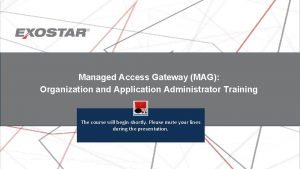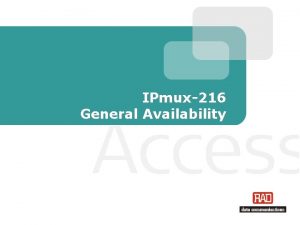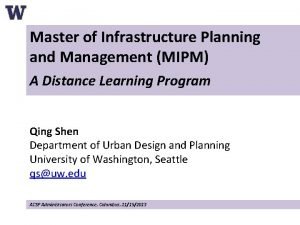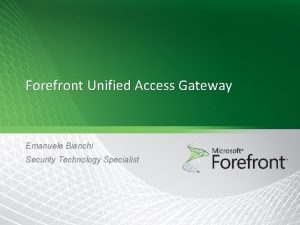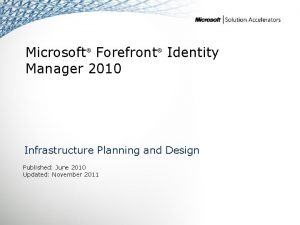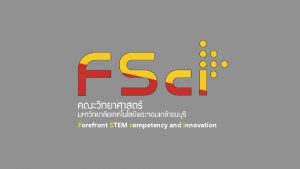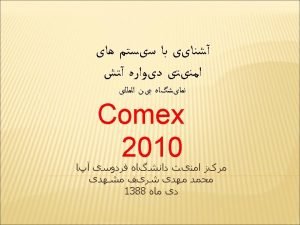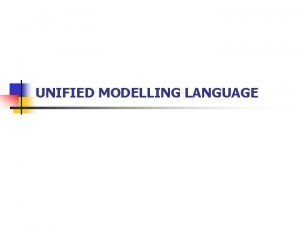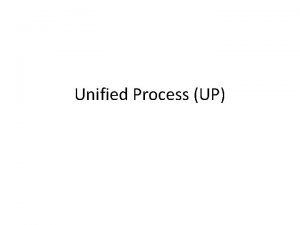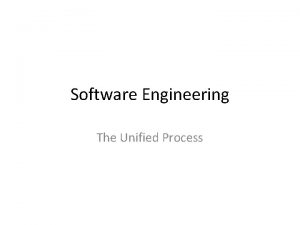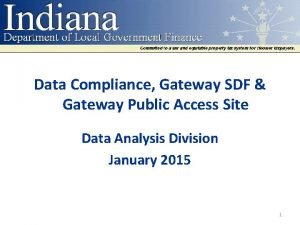Microsoft Forefront Unified Access Gateway Infrastructure Planning and


















- Slides: 18

Microsoft® Forefront® Unified Access Gateway Infrastructure Planning and Design Published: December 2009 Updated: July 2010

What is IPD? Guidance that clarifies and streamlines the planning and design process for Microsoft® infrastructure technologies IPD: • Defines decision flow • Describes decisions to be made • Relates decisions and options for the business • Frames additional questions for business understanding IPD guides are available at www. microsoft. com/ipd

Getting Started Microsoft Forefront Unified Access Gateway (UAG)

Purpose and Overview Purpose • To provide guidance for designing a Forefront UAG infrastructure Overview • Forefront UAG architecture • Forefront UAG infrastructure design process

Example of Forefront UAG Architecture MDT SCM ITA

Forefront UAG Decision Flow MDT SCM ITA

Step 1: Define the Scope of the Forefront Unified Access Gateway Project • Task 1: Define the scope of the project • • • Define client populations Define corporate resources client populations will access via Forefront UAG Whether Direct. Access will be used • Task 2: Determine the client requirements • • • Where are the client machines located? Will client machines travel between locations? What client operating systems and browsers are in use? What Forefront UAG functionality will the client workstation use? Whether the client will use Direct. Access. Fault-tolerance requirements. • Task 3: Determine the endpoint health approach • • Forefront UAG built-in access policies Network Access Protection (NAP) policies

Step 2: Determine the Number of Forefront Unified Access Gateway Instances Required • Task 1: Decide the number of Forefront UAG instances required • Add more instances if necessary for: • Both Direct. Access and VPN clients • Align with organization’s management model or regulatory reasons • Network isolation • Services beyond the trust boundary

Step 3: Design the Server Infrastructure • Task 1: Design and place the Forefront UAG server • Task 2: Design fault tolerance and scale out • Note that if Forefront UAG is used to provide an array for Direct. Access, use of hardware load balancer is not supported • Task 3: Design the data store • Built-in Forefront UAG reporter to log events. Log files can be placed on clustered file server if fault tolerance is required. • RADIUS accounting server is in NPS and is a second option to log events.

Dependencies • The Forefront UAG installation program automatically installs a customized version of the Microsoft Forefront Threat Management Gateway (Forefront TMG). Forefront UAG utilizes many functions that are in Forefront TMG, including the array and the firewall. It also stores the publishing rules for the Forefront UAG portal. If Forefront TMG is uninstalled from a Forefront UAG server, this creates a configuration that Microsoft does not support. • Note that Forefront UAG does not support the stand-alone version of Forefront TMG; the only supported configuration is where Forefront UAG automatically installs its own version of Forefront TMG. • Further information about Forefront TMG’s role when used with Forefront UAG is available at http: //technet. microsoft. com/en-us/library/ee 522953. aspx.

Summary and Conclusion • The Forefront UAG guide has addressed the fundamental decisions and tasks involved in: • Defining the scope of the Forefront UAG project • Determining how many Forefront UAG instances will be required • Designing the Forefront UAG instances and the server infrastructure in them • This guide offers major architectural guidance. Refer to product documentation for additional details. • Provide feedback to satfdbk@microsoft. com

Find More Information • Download the full document and other IPD guides: www. microsoft. com/ipd • Contact the IPD team: satfdbk@microsoft. com • Access the Microsoft Solution Accelerators website: http: //www. microsoft. com/technet/Solution. Accelerators

Questions?

Addenda: • Benefits for Consultants or Partners • IPD in Microsoft Operations Framework 4. 0 • System Center Operations Manager 2007 in Microsoft Infrastructure Optimization

Benefits of Using the Forefront UAG Guide • Benefits for Business Stakeholders/Decision Makers – Most cost-effective design solution for implementation – Alignment between the business and IT from the beginning of the design process to the end • Benefits for Infrastructure Stakeholders/ Decision Makers – Authoritative guidance – Business validation questions ensuring solution meets requirements of business and infrastructure stakeholders – High integrity design criteria that includes product limitations – Fault-tolerant infrastructure – Infrastructure that’s sized appropriately for business requirements

Benefits of Using the Forefront UAG Guide (Continued) • Benefits for Consultants or Partners – – Rapid readiness for consulting engagements Planning and design template to standardize design and peer reviews A “leave-behind” for pre- and post-sales visits to customer sites General classroom instruction/preparation • Benefits for the Entire Organization – Using the guide should result in a design that will be sized, configured, and appropriately placed to deliver a solution for achieving stated business requirements

IPD in Microsoft Operations Framework 4. 0 Use MOF with IPD guides to ensure that people and process considerations are addressed when changes to an organization’s IT services are being planned.

Forefront UAG in Microsoft Infrastructure Optimization
 Microsoft forefront protection 2010 for exchange server
Microsoft forefront protection 2010 for exchange server Ms forefront client security
Ms forefront client security Microsoft forefront security for exchange server
Microsoft forefront security for exchange server Microsoft forefront
Microsoft forefront Cisco pstn gateway
Cisco pstn gateway Cisco uci
Cisco uci Unified communications infrastructure
Unified communications infrastructure Unified access control
Unified access control My exostar
My exostar Tdm pseudowire access gateway
Tdm pseudowire access gateway Forefront online protection
Forefront online protection Forefront security solutions
Forefront security solutions Universal screeners for number sense
Universal screeners for number sense Forefront identity manager tutorial
Forefront identity manager tutorial X-forefront-antispam-report
X-forefront-antispam-report Microsoft learning gateway
Microsoft learning gateway Masters in infrastructure planning and management
Masters in infrastructure planning and management Open access infrastructure
Open access infrastructure Microsoft infrastructure optimization
Microsoft infrastructure optimization








